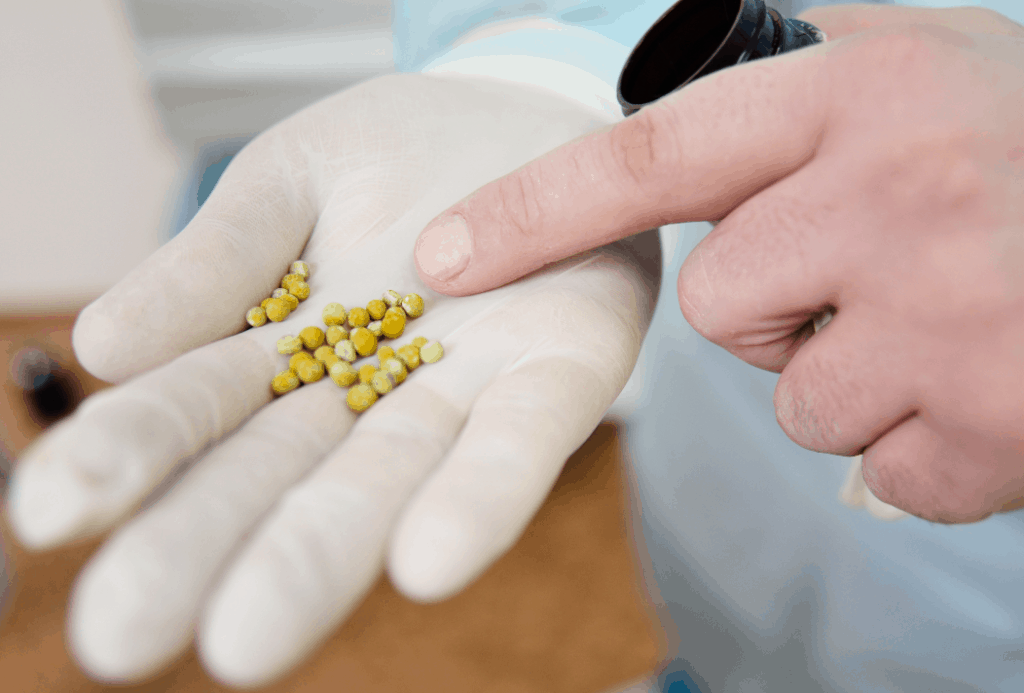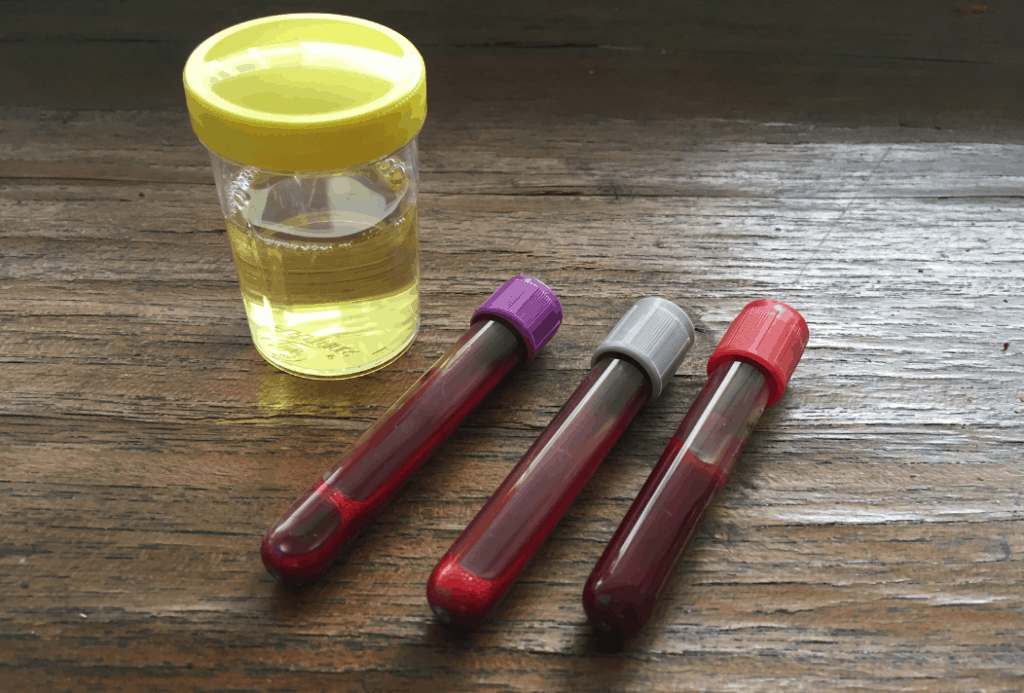If There’s Blood in your Dog’s Urine it Could be Cystitis
It can be very scary to see blood in your dog’s urine and you may feel a sense of exasperation when seeing it for the first time. But what does blood in your dog’s urine actually mean? Rest assured, there are usually many reasons your dog may be urinating blood, many of which are easily diagnosed and treated. We will discuss those here, as well as the rare instances when it may be a more serious condition.
When you take your dog in to be evaluated for urinating blood your veterinarian may refer to your dog as having a condition called “cystitis”. Cystitis means “inflammation in the bladder”, though it can generally refer to inflammation in the urethra as well. Together, the bladder and urethra make up what we call the lower urinary tract.
So, what causes inflammation in the lower urinary tract of a dog, and is it an emergency? We’ll go over everything you need to know in this article.
Causes of Cystitis in dogs
- The most common cause of cystitis in dogs is a urinary tract infection. Urinary tract infections are very common, especially puppies and older dogs.
- Other common causes of cystitis are urinary crystals and bladder stones.
- In older, male dogs, prostatitis can also cause cystitis.
- A rare, but more serious cause of cystitis is bladder or urethral cancer, which may be more likely to occur in middle aged to older dogs.
If there’s blood in your dog’s urine and it’s not cystitis, it may be more serious.
Mediated Hemolytic Anemia
Very rarely, a dog may urinate blood, but it’s not due to inflammation in the bladder, and instead due to an autoimmune condition called Immune Mediated Hemolytic Anemia, where the dog’s immune cells are attacking the red blood cells. This can result in it appearing as though your dog is urinating blood.
Clotting disorders or ingested toxins
Another cause of this could be if your dog has a clotting disorder or ate a toxin, such as certain types of rat poison.
These situations would be emergency and life-threatening, so it is always important to have your pet evaluated by your veterinarian as soon as possible if you suspect these could be the cause.
What are the Symptoms of a bladder infection?
Your dog seems uncomfortable
Dogs that are experiencing inflammation in their bladder or urethra usually are uncomfortable and they may posture to urinate multiple times in a short timeframe, with just small amounts of urine coming out each time.
There are a few urine accidents inside
They may even have some urinary accidents in the house because they feel such an urge to urinate they just can’t hold it in time to get outside.

Constant licking
Your dog may lick constantly at their vulva or prepuce due to the feeling of inflammation and discomfort, as they try to soothe it.
Increased thirst
Sometimes they may seem to drink more water than usual or even urinate more than usual.
It’s very important to note that If you see your dog straining to urinate with nothing coming out for a 12-24-hour period, you should take them to your veterinarian as soon as possible. Your vet can make sure your dog’s bladder isn’t obstructed from something such as a bladder or urethral stone.
Diagnosing the Cause of Cystitis
As mentioned above, there are various causes of cystitis. There are also various ways of diagnosing what the underlying cause of it may be.
Step 1: the at-home urinalysis
The first step would be to collect a urine sample from your dog and performing what we call a “urinalysis”. This allows your veterinarian to look for things in your dog’s urine, such as bacteria, red and white blood cells (which may indicate inflammation and irritation), glucose (sugar), crystals, abnormal cells, and the urine’s concentration.
Step 2: Diagnostics performed by your vet
Other diagnostics that may need to be performed are urine cultures, abdominal x-rays, an abdominal ultrasound, or urethroscopy (using a video scope to look within the urethra and bladder). Sometimes a blood sample may need to be taken to help determine the underlying cause. A urine culture is usually needed when a dog has a recurring urinary tract infection or one that just won’t get better on typical antibiotics alone. A culture is performed in a laboratory, where they grow the bacteria and do testing to find out what specific antibiotic is needed to treat the infection.
Step 3: X-rays will be needed for suspected bladder stones or tumors
Your veterinarian may recommend abdominal x-rays if they suspect bladder or urethral stones, or even prostatitis. Most bladder stones will show up on x-rays, however there is a type of stone that will not show up on x-rays, and an abdominal ultrasound will then have to be performed to be able to visualize it. Another reason an abdominal ultrasound would need to be performed is if your veterinarian suspects your dog may have a bladder or urethral tumor growing, or a problem with their prostate.

Treatment and What to Expect
Cystitis is commonly treated with antibiotics & pain medication
As the majority of cases of cystitis in dogs are caused by urinary tract infections caused by bacteria, the most common treatment is a course of antibiotics. If your dog is in quite a lot of pain, your veterinarian may also prescribe a short course of an anti-inflammatory pain medication to help your dog feel some relief while the antibiotic starts working to kill off the bacteria.
If your dog’s cystitis is due to prostatitis, this can usually be adequately treated with antibiotics and anti-inflammatories, but it may recur again in the future.
Worming medication could also be the answer
In very few cases, the urinary tract infection may be caused by a parasite and this can be treated with deworming medications.
Multiple infections or long lasting infections will need further evaluation
Most urinary tract infections are short-lived and won’t happen again or at least for a long time. However, if a dog has multiple urinary tract infections within a short period of time, such as a few weeks or months, your veterinarian may recommend checking either blood work to evaluate for an underlying metabolic cause such as Diabetes or Cushing’s Disease, or an abdominal x-ray to evaluate for bladder stones.

Bladder stones will need to be removed & a prescription diet may be prescribed
If the cystitis is due to bladder stones, the ideal treatment is surgery to remove the stones from the bladder.
Occasionally, depending on the suspected type of stone present, a prescription diet (manufactured dog food) can be fed to your dog long-term to help the bladder stone dissolve on its own and decrease the risk of it forming again. These diets can only be used in cases where the stone is not obstructing the ability of your dog to urinate and in cases where the suspected stone is specifically a “struvite” stone. Prescription diets will not work for other types of bladder stones, unfortunately. Additionally, sometimes mixed-type stones will be present, preventing the diet from being able to adequately dissolve the stone. Once surgery is performed to remove the bladder stone, the stone can be sent to a laboratory to be analyzed to determine exactly what type of stone it is and what specific diet can be fed to your dog to help decrease the risk they may form another stone in the future.
Treatment for bladder tumors is more difficult.
If, on the rare occasion, a dog is diagnosed with a bladder tumor, this is a very poor prognosis. Most bladder tumors cannot be removed surgically, and the dog will need to be given chemotherapy and pain medications long-term to keep them comfortable. These cancers are rare, but do occur in some dogs.
Cystitis can be very different from one dog to the next, it all depends on the cause.
As you can see, there are many different causes of cystitis in dogs. If your dog is straining to urinate and seems uncomfortable, or you see blood in your dog’s urine, it is best to take them to your veterinarian. Your vet can help to quickly figure out the cause, giving both you and your dog some much needed relief.
The post If There’s Blood in your Dog’s Urine it Could be Cystitis appeared first on VetBabble.




Post a Comment